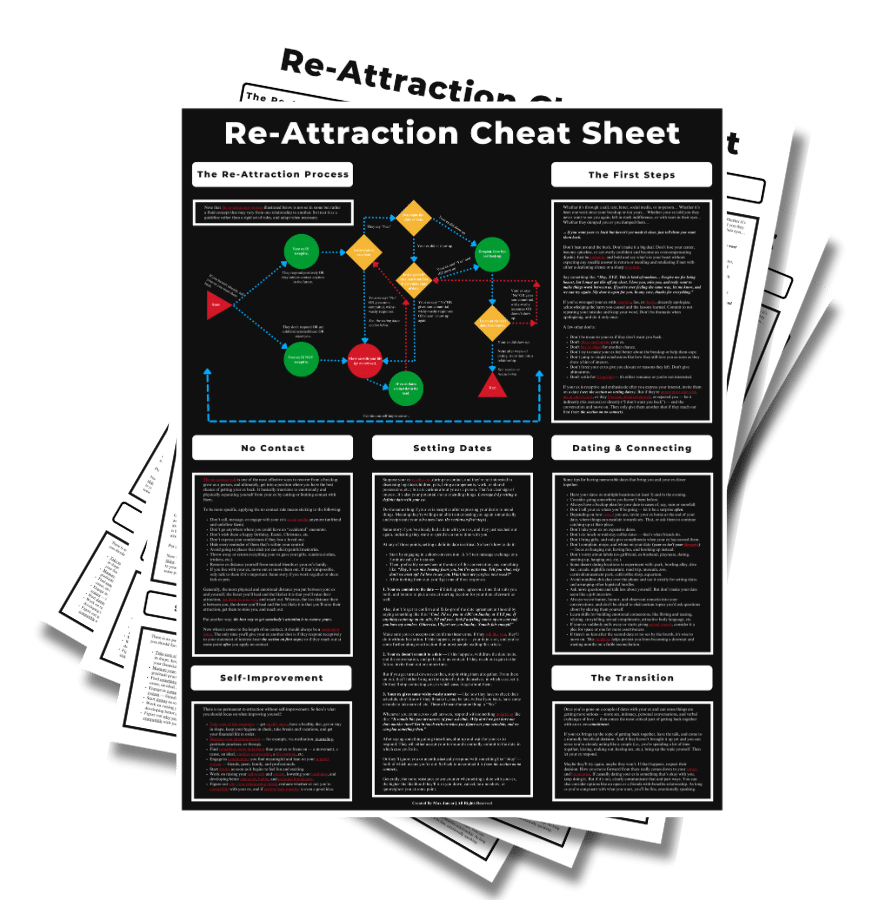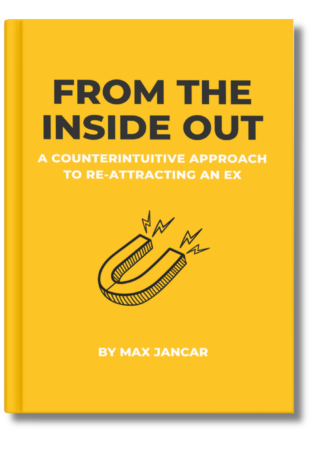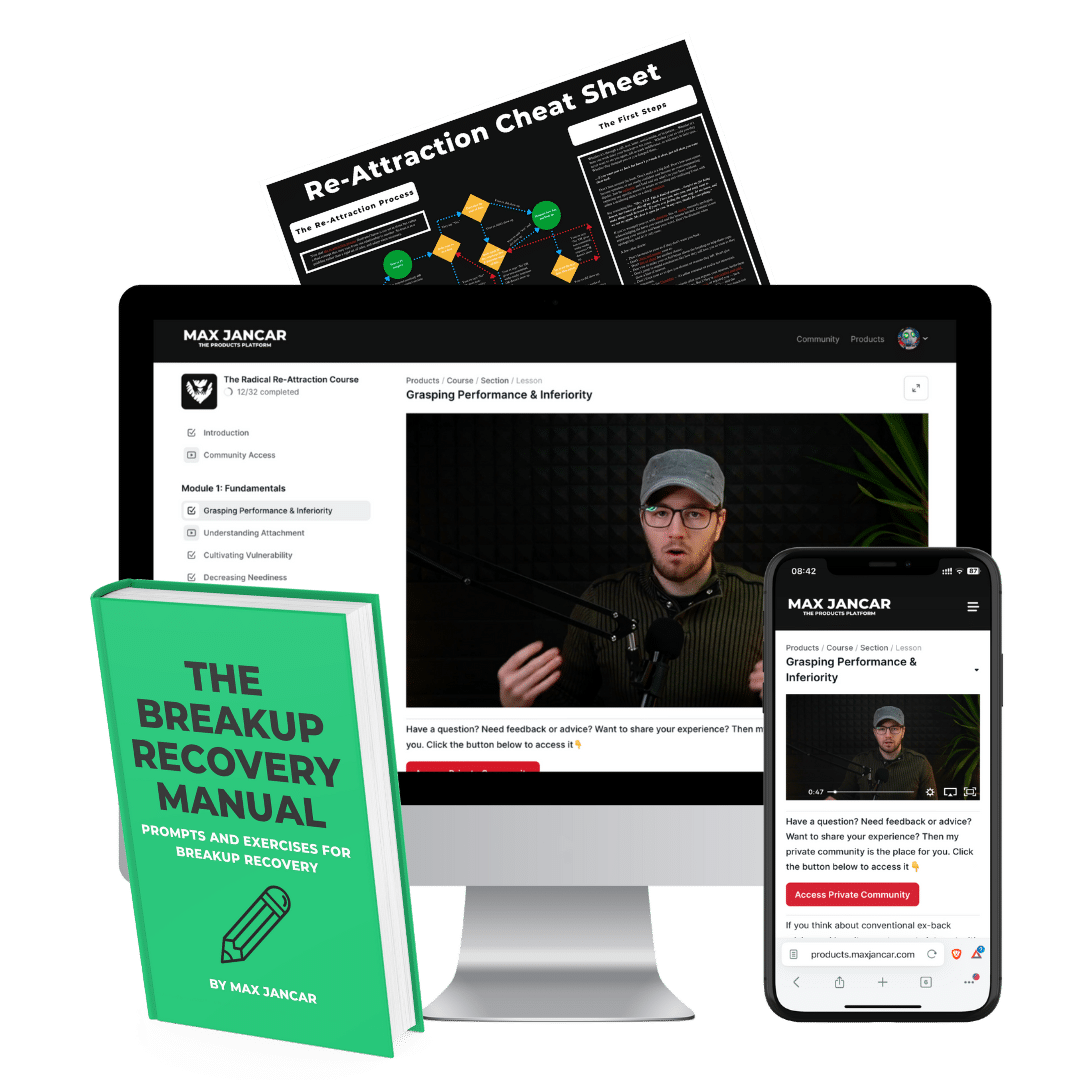Click play to listen to this article.
If you’ve been in a relationship where your ex’s openness to intimacy and need for space persistently wigwagged like a pendulum, there’s a good chance they’re fearful-avoidant. And if you’re like most people, you’re probably worried that you’ll lose them forever by going no contact.
Well, fear not. Nine times out of ten, going no contact with a fearful-avoidant ex dramatically raises their attraction for you. In fact, the longer you are in no contact, the more likely they’ll think about you in general. And then that can progress to them missing you and eventually reaching out, from which point mending things becomes much more manageable.
But I’m getting ahead of myself. Let’s start from the beginning.
Who Is A Fearful-Avoidant
The theory goes that everyone possesses one of four attachment styles, predominantly influenced by their childhood and upbringing:
- Anxious attachment, characterized by an excessive need for closeness and validation.
- Avoidant attachment, characterized by an excessive need for space and independence.
- Secure attachment, characterized by little to no excessive anxious or avoidant tendencies.
- Fearful-avoidant attachment, characterized by an excessive and shifting need for closeness and validation, as well as space and independence.
For an in-depth guide on all four attachment styles, read my article on attachment theory. For this article, however, I’ll mainly focus on fearful-avoidant attachment for relevancy’s sake. Let’s unpack it.
Fearful-avoidants have usually experienced a severely traumatic childhood. One where caregivers were continually unpredictable, sometimes being nurturing and responsive and at other times being unavailable or intrusive.
As a result of such childhood, fearful-avoidants might have moments where they seem deeply in love and receptive, only to suddenly withdraw and become distant or cold (read: mixed signals).
This back-and-forth reflects their irrational fears — the fear of getting too intimate with another person and the fear of getting too distant. Both of which only push the other person away.
It’s due to this complex web of insecurities that going no contact with a fearful-avoidant can be such a mindfuck.
This is the ultimate ex-back guide. It's a 200-page book that shows you how mend your relationship through honesty and staying true to yourself.
Learn More HereWhat Is The No Contact Rule
For a thorough masterclass on the no contact rule, read this article. But here’s a brief introduction, so we’re all on the same page.
The no contact rule is the act of emotionally and physically separating yourself from your ex by, as the name implies, cutting or limiting contact with them. As soon you apply no contact, you stick to the following:
- Don’t text and call your ex anymore.
- Stop engaging with their social media.
- Avoid visiting places that could draw out painful memories.
- Hide everything that reminds you of your ex.
- Throw away or return everything they gave you.
- Distance yourself from mutual friends and your ex’s family (or cut them out altogether).
- If you live with your ex, move out or move them out. If that’s not an option, talk to them only if it’s important. The same goes when you share kids and pets or work together.
The dumb thing about no contact is that it’s often portrayed as this manipulation tactic you’d use to get an ex back faster. In reality, it has very little to do with one’s ex and much more to do with your one’s recovery.
No contact is a process of inward growth rather than an outward expression of disinterest.
Put another way, no contact allows you to take time away from the push-pull dynamics often accompanying re-attraction. That, and it helps you reel in your panic and release some of your angst as you avoid interacting with your ex for an indefinite period.
But that’s not all.
By avoiding contact, you give yourself time to reflect on your dead relationship and learn from it, leading to fewer repeated mistakes. You also create a need for yourself in your ex’s life. As they say, the best way to get someone’s attention is to remove yours.
Cut out the worry and confusion with my online interactive course. Inside you'll learn step-by-step how to get back with your ex for good, so you'll know exactly what to do.
Get Instant AccessWhat To Expect When Going No Contact With A Fearful-Avoidant Ex
Going no contact with a fearful-avoidant ex can be a complex process to navigate, both emotionally and practically. That said, here is what you can expect when you start.
Just note that not everyone experiences the following pattern. It’s just one that I see with most people who go no contact with a fearful-avoidant ex.
Initially, your ex will likely feel relief and a sense of reclaiming their independence. Soon after, however, comes a period of confusion. A period where your ex feels a mess of emotions.
On the one hand, they’ll still feel elated and excited to be single, per se. On the other hand, they’ll begin to yearn a deep, intimate connection that they can only have with a more serious partner.
After enough time passes, assuming you’ve stuck with no contact, they may start to miss you. Perhaps even daydream about you at times.
Next comes a period of comparison — when your ex constantly compares their dates with you. This may pique their curiosity and lead them to check your social media profiles, stalk you, or unblock you if you’re currently blocked.
If you’ve maintained no contact up to this point, your ex may even begin revisiting places where you spent time together, further inflaming their daydreaming, fantasizing, and perhaps even rumination about the relationship you once had.
From there — unique to fearful-avoidants — your ex might experience intense swings between wanting to reach out and wanting to maintain distance. As I suggested earlier, this is due to their excessive and shifting need for closeness and validation, as well as space and independence.
It’s during this peak period that a fearful-avoidant ex may reach out. And that’s your cue for initiating the re-attraction process by inviting them on a date. More on this later.
How To Approach Going No Contact With A Fearful-Avoidant Ex
Before going no contact with a fearful-avoidant ex, you should communicate that you want to rekindle things. I’d say something like:
I just need to get this off my chest real quick. I still love you and truly want to mend things. Let me know if you’re ever feeling the same way, and we can try again. My door is open for you. Thanks.”
Feel free to state the above through text, a phone call, social media, or in real life. It doesn’t matter.
However, what does matter is that if your ex is receptive and wants to see you after stating your interest, you invite them on a date. In this case, no contact is not needed.
But if they’re cold and unreceptive, mean or vicious, or if they’ve blocked, ghosted, ignored, or rejected you, end the conversation and start/continue with no contact.
Note: for a step-by-step guide on how to invite your ex on a date and get the best chance for them to agree enthusiastically, read: How To Get Your Ex Back And Actually Keep Them.
How Long To Maintain No Contact With A Fearful-Avoidant Ex
When you go no contact with a fearful-avoidant ex, that no contact period should be permanent. Think of it like walking away and never looking back. You only give your ex another shot when they reach out first. Pretty simple.
Yet, I’ve encountered many ex-back coaches advocating for this complex, backward approach to no contact: wait X number of days and then reach out to your ex, usually with some pre-prepared text message.
This never made sense to me. Doing time-limited no contact only incentivizes you to passively wait for the X-day mark to pass, which limits your personal growth. It’s also needy and unattractive. And it only conveys that you have low self-respect and not much else going on in your life.
My pet theory is that all forms of X-day no contact are just a marketing gimmick. People don’t want to hear how their ex should reach out before they ever give them another chance. Fuck that! They want to hear what feels good.
And since this feel-good bullshit about waiting a certain number of days and then reaching out sells more ex-back products than the harsh truth, most people working in this slimy industry swear by it.
Fearful Avoidant No Contact: The Bottom Line
The end goal of no contact is not to get back with your ex; the end goal of no contact is to grow as an individual — to become someone more resilient, attractive, and well-rounded. Getting your ex back is simply a sexy side-effect of using no contact for the right reason.
Do not forget this.
Having a lengthy and busy no contact period — the kind where you don’t just sit around and twiddle your thumbs but actually work on yourself — is key. Not only does it make you a better person, but it also gives your ex the time to become a better person themselves.
In other words, no contact with a fearful-avoidant ex is an excellent opportunity for much-needed personal growth for both parties. And perhaps some genuine growth is just what you need to mend things for good.
(Optional) Top Questions About Going No Contact With A Fearful-Avoidant Ex
How Do I Know If Going No Contact Is The Right Decision When Dealing With A Fearful-Avoidant Ex?
Going no contact with a fearful-avoidant ex is virtually always the right decision, granted you want them back but they don’t want you back. Additionally, it’s a good idea, in particular, if interacting with your ex feels draining and frustrating. However, that is also a sign you should not rekindle things.
How Can I Prepare Myself Mentally For Going No Contact With A Fearful-Avoidant Ex?
It really boils down to making a firm yet compassionate decision to go no contact, and then remaking it every time you have the urge to reach out to your ex. It’s also useful to get clear on why you’re doing no contact in the first place and how it will actually help you, both in terms of recovery and re-attraction.
What Are Healthy Ways To Cope With The Aftermath Of Going No Contact With A Fearful-Avoidant Ex?
A few ideas: improve your sleep, take care of your health, keep your hygiene in check, experiment with meditation, journaling, and therapy, find something more important than your ex, spend more time than usual with friends and family, play around with dating, overcome your neediness and learn to be more vulnerable yet assertive.
Can Going No Contact Lead To Positive Changes In A Fearful-Avoidant Ex?
Yes. Sometimes going no contact can lead to positive changes in a fearful-avoidant ex because by backing off, you give them an opportunity to reflect on and confront their insecurities that perhaps contributed to the breakup and resolve them. Just note that when you go no contact, your focus should be on your positive changes, not your ex’s. As much fun as it is seeing them, they are irrelevant.
What Are The Signs That Going No Contact Is Working On My Fearful-Avoidant Ex?
Re-attraction-wise, signs that no contact is working include your ex reaching out, being more responsive and enthusiastic when talking to you, asking friends about you, inviting you out on dates, and directly admitting their feelings to you. For a deep-dive into these signs, read: 30 Glaring Signs Your Ex Will Eventually Come Back.
Discover a simple yet powerful approach for going no contact with a fearful avoidant ex that will help you boost your chances of getting back together with them.
Get The Free Cheat Sheet

